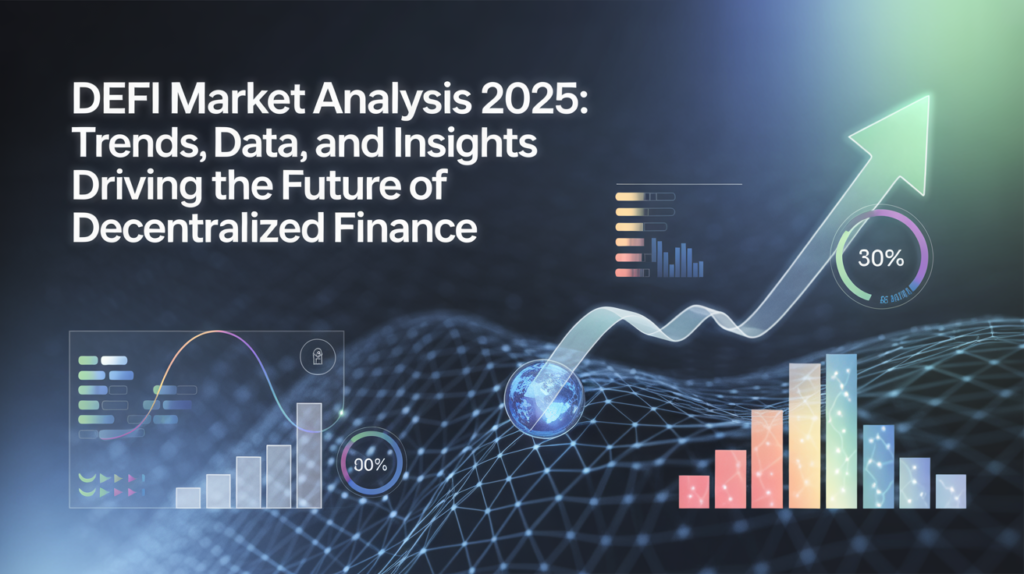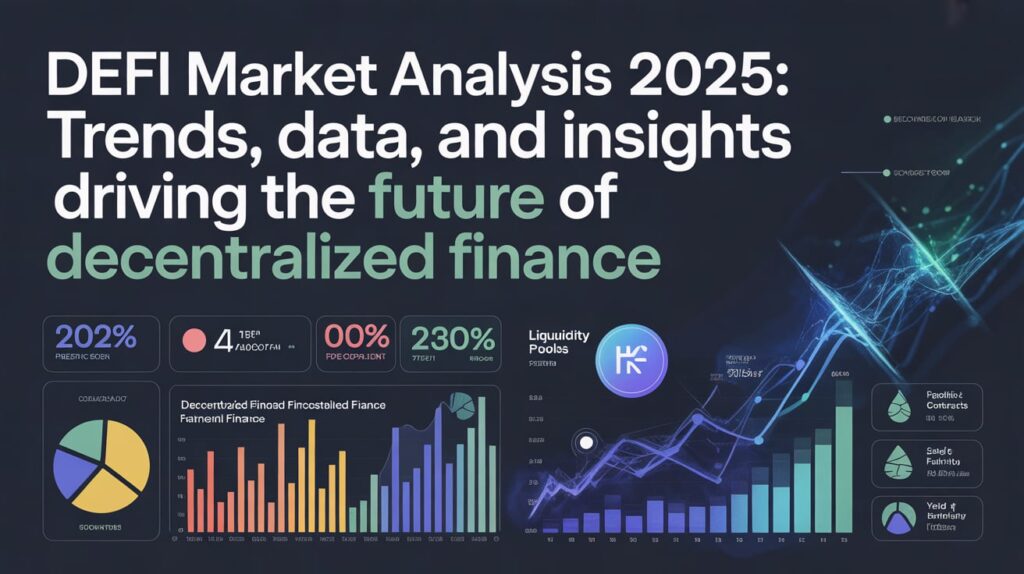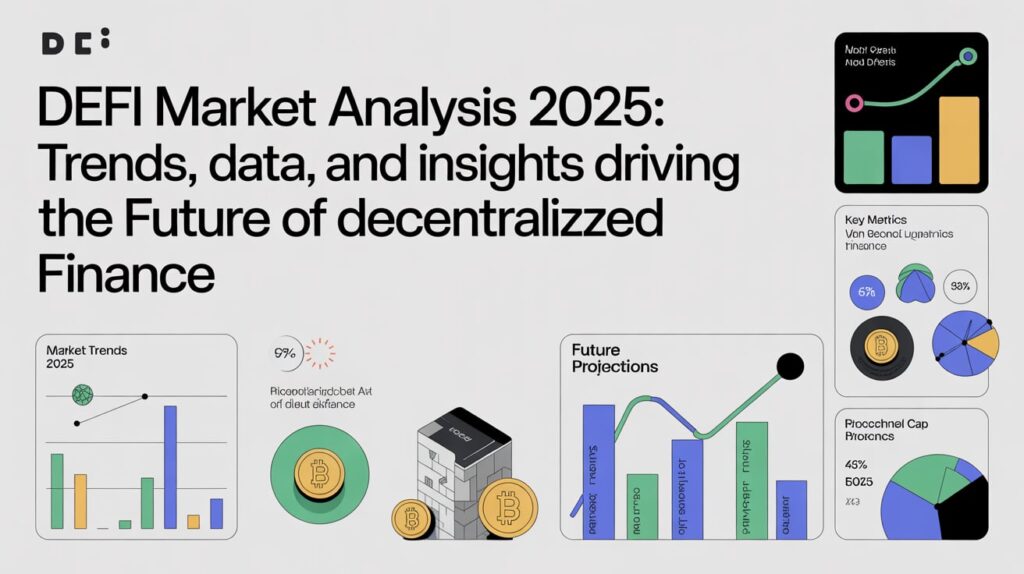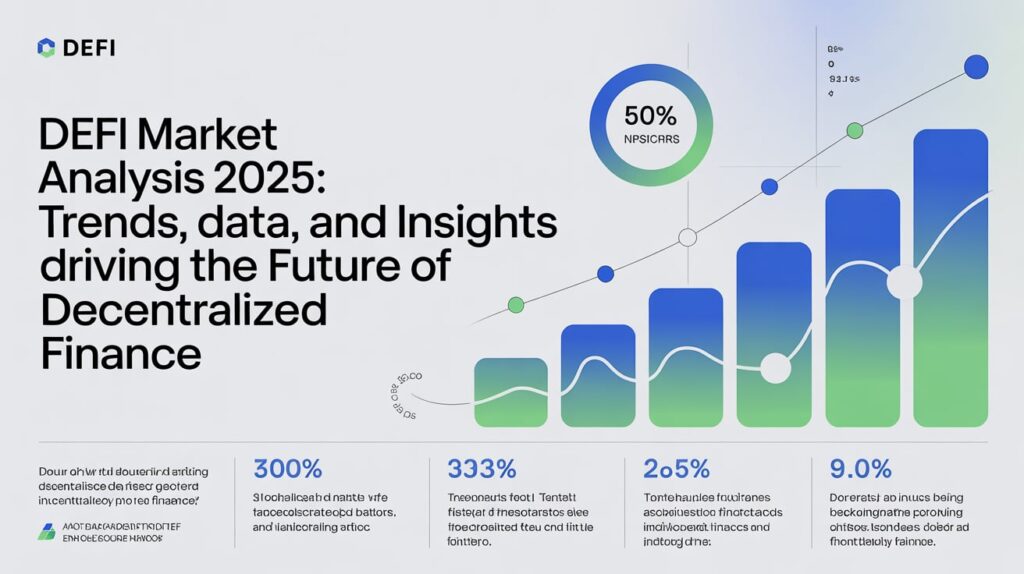Table of Contents
ToggleDeFi Market Analysis 2025: Trends, Data, and Insights Driving the Future of Decentralized Finance

In the ever-evolving world of blockchain, Decentralized Finance (DeFi) remains one of the most disruptive innovations since Bitcoin itself. What started as an experiment in 2018 has now matured into a trillion-dollar financial ecosystem.
By 2025, DeFi has become a global financial alternative — empowering millions to lend, borrow, trade, and earn without banks or intermediaries. But as the market matures, so do the dynamics, risks, and opportunities within it.
This comprehensive DeFi market analysis dives deep into the current state of decentralized finance — exploring trends, key metrics, new players, and how investors can navigate this rapidly changing environment.
Chapter 1: Understanding the Core of DeFi
1.1 What Is DeFi, Really?
At its core, Decentralized Finance is about removing middlemen from traditional financial services. Through smart contracts running on blockchains like Ethereum, Solana, and Arbitrum, users can engage in lending, borrowing, trading, and yield farming — directly, peer-to-peer.
In simpler terms:
-
Traditional finance: Controlled by banks, governments, and corporations.
-
DeFi: Controlled by code, communities, and cryptography.
This transformation marks the shift from centralized to trustless finance — where transparency and ownership take center stage.
1.2 Why DeFi Matters
DeFi is not just another crypto buzzword; it’s the foundation of the Web3 economy. It enables anyone, anywhere, to access financial tools — without borders, banks, or bureaucracy.
The key advantages include:
-
Global access to financial services
-
Passive income through staking and yield farming
-
Transparent and auditable transactions
-
New forms of liquidity and tokenized assets
In short, DeFi is democratizing money.
Chapter 2: 2025 DeFi Market Overview — The Numbers That Matter
2.1 Total Value Locked (TVL)
As of Q2 2025, global DeFi Total Value Locked (TVL) has surged past $196 billion, marking a 38% increase from the same period in 2024.
-
Ethereum still dominates with ~55% of total TVL (~$108B).
-
Arbitrum, Base, and Solana follow closely, driven by low fees and faster transaction speeds.
-
The rise of Layer-2 (L2) networks has dramatically improved DeFi scalability.
2.2 Leading Protocols
The top five DeFi platforms by TVL in 2025 are:
-
Aave V4 – $26B (Lending & Borrowing)
-
Curve Finance – $18B (Stablecoin liquidity)
-
Uniswap V4 – $16B (Decentralized Exchange)
-
Lido Finance – $13B (Liquid Staking)
-
MakerDAO (Spark Protocol) – $11B (Stablecoin Issuance)
These platforms define the backbone of the DeFi ecosystem — powering liquidity, stability, and innovation.
2.3 DeFi Market Share by Blockchain
| Blockchain | Market Share | Key Strength |
|---|---|---|
| Ethereum | 55% | Stability & Developer Ecosystem |
| Arbitrum | 15% | Low Fees, High Liquidity |
| Solana | 10% | Speed & Scalability |
| Polygon | 8% | Web3 Integrations |
| Avalanche | 6% | DeFi + Gaming Synergy |
| Others | 6% | Emerging Ecosystems |
This diversification signals a multi-chain DeFi future — where liquidity moves seamlessly across chains.
Chapter 3: Major Trends in the DeFi Market (2025 Edition)

3.1 Institutional DeFi (iDeFi)
The next big chapter of DeFi is institutional adoption.
Major banks and asset managers are now participating in DeFi liquidity pools under KYC-compliant protocols.
Platforms like Aave Arc and Compound Treasury allow institutions to earn yield through regulated environments.
3.2 The Rise of Real-World Assets (RWAs)
Tokenization of real-world assets — from U.S. Treasury bills to real estate — has become DeFi’s biggest breakthrough.
By mid-2025, tokenized RWA value surpassed $35 billion, making DeFi a legitimate bridge between traditional finance (TradFi) and blockchain.
Projects leading this trend:
-
MakerDAO’s Spark Protocol
-
Centrifuge (CFG)
-
Ondo Finance
-
Maple Finance
RWAs are redefining what “collateral” means in DeFi — making it more stable, predictable, and institutional-ready.
3.3 Cross-Chain Liquidity and Interoperability
The old “Ethereum-only” era is over. Cross-chain DeFi powered by LayerZero, Axelar, and Wormhole allows liquidity to move across blockchains in seconds.
This is solving one of DeFi’s biggest bottlenecks — fragmentation.
Interoperable protocols now enable yield farming, lending, and NFT collateralization across multiple chains seamlessly.
3.4 AI in DeFi
Artificial Intelligence is starting to play a crucial role in DeFi analytics and risk management.
AI-driven bots help:
-
Optimize yield strategies
-
Predict liquidity fluctuations
-
Detect suspicious contract activity
-
Automate portfolio rebalancing
The convergence of AI + DeFi is setting the stage for “smart money” — algorithms that learn and adapt faster than humans.
3.5 Decentralized Insurance
DeFi insurance platforms like Nexus Mutual and InsurAce are gaining traction.
As users demand protection from smart contract exploits, insurance is emerging as the “safety net” of the decentralized economy.
The insurance TVL crossed $2.3 billion in 2025 — a major leap from just $300 million in 2023.
Chapter 4: Key Challenges Facing the DeFi Market

4.1 Security and Smart Contract Exploits
Despite advancements, DeFi still faces major security concerns.
In 2024 alone, over $2.8 billion was lost to hacks and contract exploits.
Most attacks target unverified smart contracts and unaudited forks.
Common vulnerabilities include:
-
Flash loan attacks
-
Oracle manipulation
-
Permission mismanagement
-
Front-running bots
Auditing and risk analysis are now non-negotiable for serious investors.
4.2 Regulatory Pressure
Governments worldwide are tightening regulations.
The U.S. Treasury Department now enforces KYC standards for DeFi protocols with fiat gateways.
The EU’s MiCA framework has introduced licensing for DeFi liquidity providers.
While these rules bring legitimacy, they also create friction for permissionless ecosystems.
4.3 Market Saturation
Thousands of DeFi tokens have flooded the market. Most offer similar services with minimal differentiation.
Investors are now prioritizing utility, security, and long-term sustainability over hype.
4.4 User Experience & Complexity
DeFi is still intimidating for beginners.
Wallet management, gas fees, and bridging assets confuse new users.
Simplifying interfaces and integrating education will be key to future growth.
Chapter 5: Regional Overview — Where DeFi Is Growing Fastest
5.1 North America
The U.S. leads in institutional DeFi participation. Big funds and Wall Street firms are deploying capital through regulated protocols.
5.2 Europe
Europe’s regulatory clarity (MiCA) is fueling trust. Countries like Germany and France are emerging DeFi innovation hubs.
5.3 Asia-Pacific
Singapore, South Korea, and India are major growth markets. India’s youth-driven Web3 ecosystem has created over 500+ DeFi startups since 2022.
5.4 Latin America & Africa
DeFi adoption is rising due to unstable fiat currencies. People use stablecoins and lending dApps as alternatives to local banks.
Chapter 6: The Most Promising Sectors in DeFi (2025 Outlook)

-
Lending & Borrowing:
Still DeFi’s backbone, with Aave and Compound leading. -
Decentralized Exchanges (DEXs):
Aggregators like 1inch and SushiSwap dominate multi-chain trading. -
Yield Aggregation:
Yearn Finance and Beefy Finance continue automating yield optimization. -
Liquid Staking Derivatives (LSDs):
Platforms like Lido and Rocket Pool are unlocking billions in staked ETH liquidity. -
Synthetic Assets & Derivatives:
Platforms like dYdX and Synthetix are pioneering on-chain futures and tokenized indexes.
Chapter 7: DeFi Market Predictions for 2025–2030
-
DeFi TVL to exceed $500 billion by 2030
-
Integration with CBDCs (Central Bank Digital Currencies) for cross-border settlements
-
Insurance and AI to become core components of DeFi risk models
-
Tokenization of assets (stocks, gold, bonds) to reach mainstream adoption
-
Full on-chain identity systems (DID) to make DeFi more secure and compliant
Chapter 8: How to Analyze DeFi Projects (Investor’s Guide)
8.1 Key Metrics to Watch
-
TVL Growth – Measures user trust and liquidity
-
Active Wallets – Shows adoption and community activity
-
Token Utility & Emission Rate – Determines sustainability
-
Audit Reports – Confirm security and transparency
-
Revenue vs. Incentives – Indicates real vs. inflated demand
8.2 Red Flags
-
No audit or anonymous developers
-
Unsustainable APY promises
-
Centralized admin control
-
Lack of real user adoption
8.3 Fundamental vs. Speculative Value
A healthy DeFi project generates real yield from trading fees, loans, or staking — not from token inflation or hype.
Chapter 9: DeFi and the Future of Finance
DeFi is no longer a parallel system — it’s merging with global finance.
Banks are experimenting with on-chain bonds, governments are exploring blockchain settlements, and corporations are tokenizing assets.
This fusion of DeFi + TradFi represents the next financial evolution — open, programmable, and borderless.
In a world of increasing digital integration, DeFi may soon become the standard for financial infrastructure.
Conclusion: The Age of Open Finance
The DeFi market of 2025 is dynamic, data-driven, and maturing. It’s not the “Wild West” it once was — it’s the foundation of the next global economy.
While risks remain — from hacks to regulations — the long-term outlook for DeFi is undeniably bullish. The combination of innovation, transparency, and community-driven governance is shaping a financial future that’s more inclusive than ever.
As investors, builders, or curious observers, one lesson stands out:
DeFi isn’t just about money — it’s about empowerment.
The future of finance is decentralized, data-backed, and in your hands.